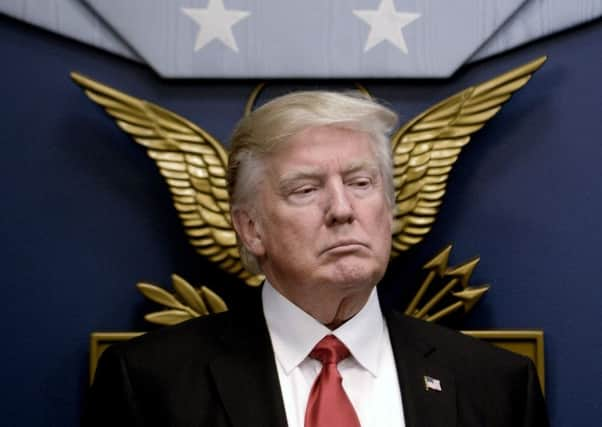Martyn McLaughlin: Data is being twisted by Trump to push his dark agenda


The machine of the US federal government is routinely derided by its critics as unwieldy and inefficient, charges which are not without merit, but given the integral role it plays in shaping American life, its scale and scope is necessarily vast.
At its core, this hulking apparatus chews and spits out an infinity of numbers, percentages, ratios and formulae about life in the third most populous country in the world. It is an engine calibrated to bring order to chaos, in doing so producing torrents of raw data that might be melded into something greater, something better.
Advertisement
Hide AdAdvertisement
Hide AdIts empirical mission spans a bewildering miscellany of topics, harvesting details of the most popular baby names and honeybee pollination rates, while charting the gender of victims of motor vehicle thefts and illustrating a nation’s changing television viewing habits.
Delve into the sea of figures and you will find whatever quirk you seek. It can tell you, down to the last dollar and cent, the annual mean expenditure by the average African-American on processed vegetables.
If these examples are suggestive of a system given to frivolous pursuits, the US is about to discover how vital statistics are in shaping political discourse, and how easily they can be misrepresented by an administration with scant respect for decency or democracy.
The haste with which the US President, Donald Trump, has set about dismantling the framework of the post-war American project has inevitably focused on the most contentious of his policies, but peer into the footnotes of his executive orders and the long game becomes clear.
Take last Friday’s order, which banned nationals from seven Muslim majority nations from entering the US. It is a malevolent decree that has attracted international derision, yet no discussion of a few paragraphs buried away towards its end.
It comprises a directive to the Department of Homeland Security (DHS), stipulating the agency should produce twice-annual datasets “regarding the number of foreign nationals in the US who have been charged with terrorism-related offenses while in the US; convicted of terrorism-related offenses while in the US; or removed from the US based on terrorism-related activity”.
Even the most junior staffer at the DHS would be forgiven for greeting this edict with a certain puzzlement. It has been well established that acts of terrorism – itself a broadly defined crime – is a threat the US faces from within.
Widely cited research by the New America Foundation, a Washington think-tank, has shown that out of the 499 extremists who have committed an offence on US soil since 2001, some 80 per cent were either US-born or naturalised citizens.
Advertisement
Hide AdAdvertisement
Hide AdIn light of such findings, it would be tempting to dismiss the order as hopelessly wayward, but then again, it is important to remember that under his administration, statistics will serve a unique purpose – to aid propaganda rather than inform policy.
His order to the DHS is expressly designed to ignore inconvenient truths and instead establish a skewed data-reporting mechanism which deflects attention on to the minority Mr Trump and his acolytes know they must vilify in order to propagate their world view; if you change the way statistics are gathered, you change the story they tell.
This is no blip; the first week of the Trump government offers ample evidence that the process of manipulation is under way. Its order to restrict communications by the Environmental Protection Agency effectively muzzles an institution perceived by climate change skeptics inside 1600 Pennsylvania Avenue as a nuisance to their ideology.
Other agencies deemed as obtrusive to the Trump administration’s political goals will be next. Last week, the White House press secretary Sean Spicer failed to answer a straightforward question about the national unemployment rate, insisting that Mr Trump is “not focused on statistics as much as he is on whether or not the American people are doing better as a whole”.
It was a remarkable statement, one you can be sure rattled staff at the Bureau for Labour Statistics and the Bureau for Economic Analysis. During his campaign, Mr Trump dismissed the latter’s stated unemployment figure of 4.9 per cent as “one of the biggest hoaxes in American modern politics”. Instead, he posited that the real number was 42 per cent.
That claim, like so many of Mr Trump’s, went uncorroborated; hardly a surprise for a birther, vaccine sceptic, and denunciator of climate change as a Chinese hoax who has shown nothing but disdain for evidence-based political practice.
But now that he is in power, Mr Trump does not have to ignore statistics – he can change the data federal statisticians report and how they report it, or squeeze the funding on which such research depends. Whatever the means, the end is the same – advancing his administration’s agenda. That poses an extraordinary challenge, not only for those seeking to wrest him from the White House, but ordinary policy discourse which has until now implicitly trusted the way in which government data is being collated, analysed and disseminated.
The clerks, scientists, and statisticians of the federal government are anonymous, but now is the hour of the bureaucrats. Only they can stand up and speak out whenever information is being distorted or suppressed. Theirs is an unwieldy and inefficient machine, but it can kill fascists and their regimes.